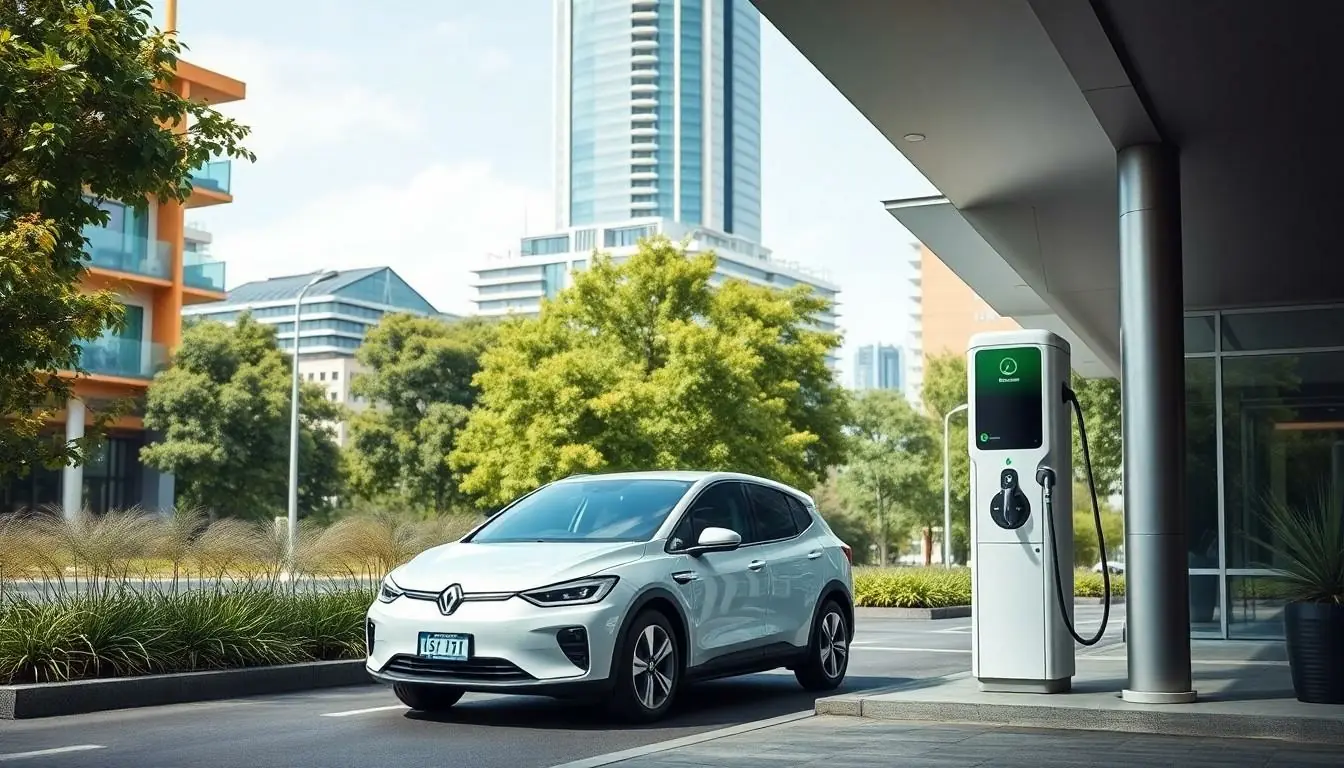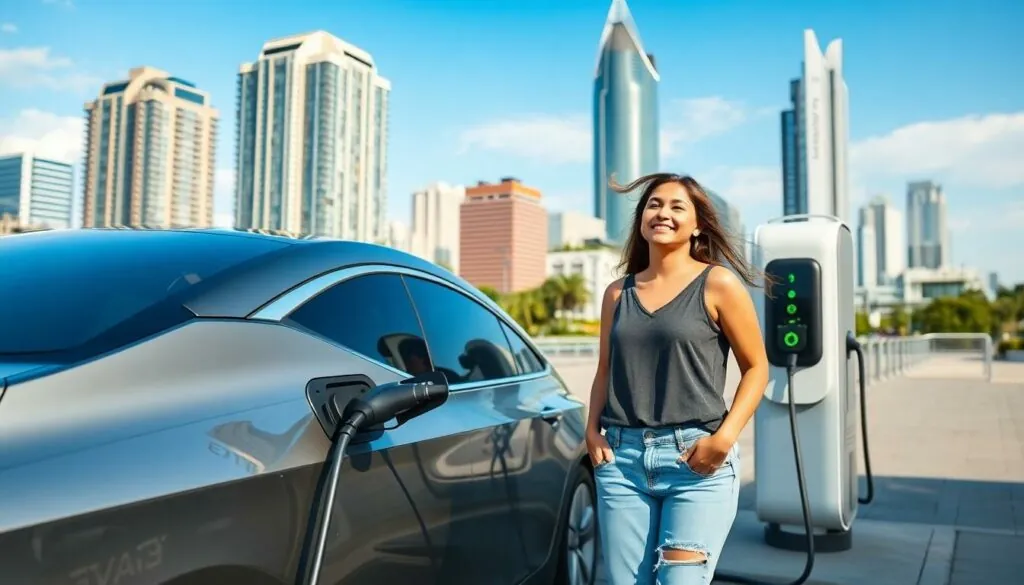Table of Contents
ToggleAustralia’s roads are about to get a serious upgrade. With electric vehicles (EVs) zooming into the spotlight, it’s time to say goodbye to gas-guzzlers and hello to a greener future. Picture this: cruising down the coast in a sleek EV, the only sound is the wind in your hair and the occasional “wow, look at that!” from passersby. It’s not just a dream; it’s the new reality for Aussie drivers.
As the world shifts gears towards sustainability, Australia is catching up, and the benefits are electrifying. From reducing emissions to saving on fuel costs, EVs are more than just a trend—they’re a smart choice for the environment and your wallet. So, buckle up as we dive into the ins and outs of electric vehicles in Australia and discover why it’s time to plug in and drive into the future.
Overview of Electric Vehicles Australia
Australia’s electric vehicle (EV) market is experiencing significant growth. Adoption rates have increased due to heightened consumer awareness and government incentives. In 2023, EV sales accounted for approximately 6% of total vehicle sales, showcasing a clear trend toward sustainable transportation.
Many factors contribute to the rise of EVs in Australia. Lower operating costs play a crucial role since EVs typically require less maintenance than traditional vehicles. Environmental benefits also attract consumers, as EVs emit no tailpipe pollutants.
Major cities are enhancing their infrastructure to support this shift. Charging stations are being installed throughout urban and rural areas, making long-distance travel feasible for EV owners. Efforts to improve grid capabilities ensure that renewable energy sources, like solar and wind, can power these vehicles sustainably.
Government initiatives support EV integration into the market. The Australian government has set ambitious targets for reducing greenhouse gas emissions. Incentives include rebates and tax reductions for EV purchases, encouraging more individuals to make the switch.
Several automakers have committed to producing electric models tailored to the Australian market. Local manufacturers are developing EVs equipped with features catering to local driving conditions. Consumers can choose from various models, including compact cars and SUVs, making it easier to find an EV that fits their needs.
With advancements in technology, battery ranges continue to improve. Current EV models offer ranges between 200 and 600 kilometers on a single charge, alleviating concerns about running out of power. Enhanced battery technology also results in shorter charging times, further promoting EV adoption.
Electric vehicles represent a pivotal change for Australia. As adoption rates grow and infrastructure develops, the country moves toward a cleaner, more sustainable future.
Current Electric Vehicle Market Trends

Australia’s electric vehicle market continues to experience notable growth. This expansion aligns with a global shift towards sustainable transportation, driven by environmental consciousness.
Sales Growth in Australia
Sales of electric vehicles in Australia surged in 2023, reaching approximately 6% of total vehicle sales. Factors fueling this increase include rising consumer awareness of environmental issues and the appeal of lower total ownership costs. Significant government incentives, such as rebates and tax reductions, enhance affordability for buyers. As charging infrastructure becomes increasingly accessible, owning an EV is more practical, enabling the expansion of the customer base. Major cities invest in establishing more charging stations, allowing for convenient long-distance travel. Overall, the trend indicates a continued trajectory towards higher EV sales.
Key Manufacturers and Models
Major automakers are actively entering the Australian electric vehicle market, introducing a variety of models. Manufacturers like Tesla, Nissan, and Hyundai play key roles in this expansion. Tesla’s Model 3 remains a popular choice among consumers due to its performance and range. The Hyundai Kona Electric offers versatility and a competitive price point. Additionally, models from Australian brands, like the forthcoming electric offerings from Ford and Toyota, cater to local preferences. Each new model brings advanced features and improved battery technologies. This variety boosts consumer confidence in electric vehicles and promotes further adoption.
Government Policies and Incentives
Government policies play a crucial role in promoting electric vehicles (EVs) in Australia. Various incentives encourage buyers to make the switch to electric.
Financial Incentives for Buyers
Rebates are available for those purchasing electric vehicles. Federal and state governments offer grants that can reduce the overall purchase price significantly. Tax exemptions on EVs also apply, making them more attractive options for buyers. In New South Wales, for example, individuals can receive up to $3,000 off new EV purchases. Some fully electric models may qualify for further incentives, enhancing savings. Overall, these financial incentives help lower barriers for consumers, thereby boosting EV adoption across the country.
Infrastructure Development Initiatives
Investments in charging infrastructure are expanding rapidly, supporting the growing number of electric vehicles. The Australian government allocated over $200 million for EV charging stations, ensuring accessibility in urban and rural areas. Initiatives include working with local councils to install charging points in public spaces. Partnerships with private companies also enhance the network, aiming for thousands of new chargers nationwide by 2025. Coordinated efforts enable long-distance travel, reducing range anxiety for EV owners. Overall, these infrastructure developments play a key role in facilitating the transition to electric mobility.
Environmental Impact of Electric Vehicles
Electric vehicles (EVs) play a vital role in reducing environmental harm in Australia. The shift to EVs directly contributes to lowering carbon emissions across urban and rural areas.
Reduction in Carbon Emissions
Electric vehicles significantly cut carbon emissions compared to traditional gas-powered vehicles. In 2023, the average EV emits approximately 70% fewer greenhouse gases over its lifetime. Electric vehicles offer a cleaner alternative, especially when powered by renewable energy sources. In Australia, the shift to EVs could reduce transport sector emissions by 45% by 2030, positioning the country closer to its climate targets. Government initiatives, such as the commitment to net-zero emissions by 2050, align with the increase in EV adoption. As charging infrastructure expands, more Australians will likely choose electric models, further decreasing reliance on fossil fuels.
Benefits to Urban Air Quality
Electric vehicles improve urban air quality remarkably. These vehicles produce zero tailpipe emissions, directly impacting pollution levels in cities. Studies show that transitioning to electric models can reduce harmful pollutants like nitrogen oxides and particulate matter by over 50%. Cleaner air leads to better health outcomes for urban populations, decreasing respiratory and cardiovascular issues. Cities focusing on electric vehicles experience fewer smog episodes and improved overall livability. With more charging stations and EVs on the road, urban areas can expect substantial enhancements in air quality and public health as part of the broader environmental strategy.
Challenges Facing Electric Vehicles in Australia
Electric vehicles in Australia face several significant challenges that impact their widespread adoption. Addressing these concerns is essential for accelerating the transition to sustainable transportation.
Charging Infrastructure Limitations
Charging infrastructure remains a critical limitation for electric vehicles. Although substantial investments exceed $200 million, access to charging stations varies across urban and rural areas. In many regions, the availability of fast chargers is inadequate, creating range anxiety for potential EV owners. Some local councils struggle to install sufficient chargers, resulting in long wait times at existing stations. Additionally, high-density residential areas often lack home charging options, complicating the situation further. Public charging stations may not be evenly distributed, leaving some drivers without convenient access to power sources. Sustainable growth of charging networks is vital for enhancing EV ownership.
Consumer Perception and Awareness
Consumer perception and awareness significantly influence electric vehicle adoption. Many individuals remain unaware of the benefits, such as lower running costs and environmental impact. Confusion about government incentives, including potential savings of up to $3,000, may deter buyers. Misconceptions about battery life and performance persist, leading to hesitation among prospective owners. Additionally, skepticism surrounding EV technology, especially regarding range capabilities, affects decision-making. Increased education about EV advantages is crucial for shifting perceptions and encouraging purchases. Automakers and government initiatives play a key role in facilitating this awareness through targeted outreach and informative campaigns.
Australia’s journey towards electric vehicles is not just a trend but a vital shift towards sustainability. With growing sales and supportive government initiatives, the landscape is changing rapidly. The environmental and financial advantages of EVs are becoming clear to consumers, driving demand for cleaner transportation options.
As infrastructure expands and more models hit the market, the barriers to adoption are gradually being addressed. The commitment to reducing emissions and improving urban air quality positions Australia as a leader in the EV revolution. Ongoing education and awareness efforts will further enhance this transition, paving the way for a greener future on Australian roads.




